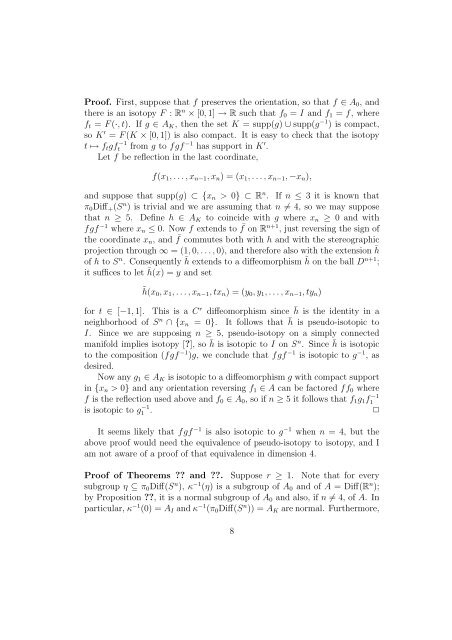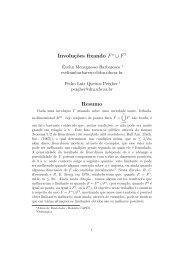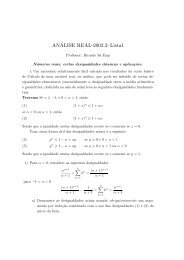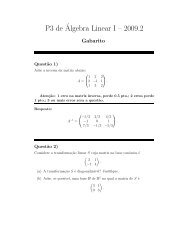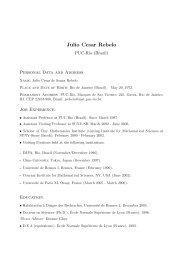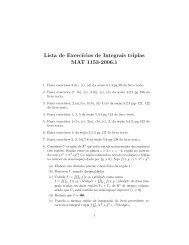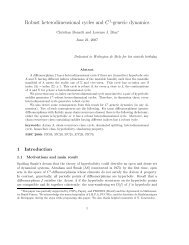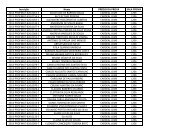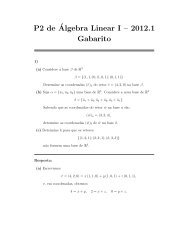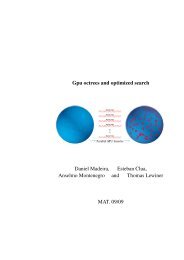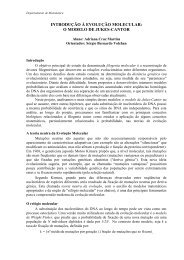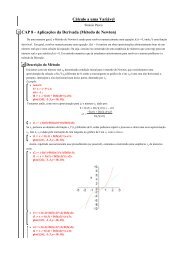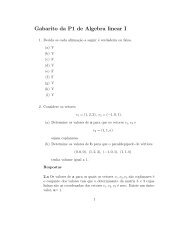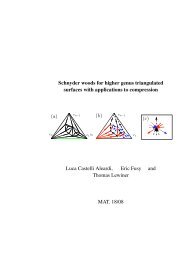NORMAL SUBGROUPS OF DIFFEOMORPHISM AND ...
NORMAL SUBGROUPS OF DIFFEOMORPHISM AND ...
NORMAL SUBGROUPS OF DIFFEOMORPHISM AND ...
You also want an ePaper? Increase the reach of your titles
YUMPU automatically turns print PDFs into web optimized ePapers that Google loves.
Proof. First, suppose that f preserves the orientation, so that f ∈ A 0 , and<br />
there is an isotopy F : R n × [0, 1] → R such that f 0 = I and f 1 = f, where<br />
f t = F (·, t). If g ∈ A K , then the set K = supp(g) ∪ supp(g −1 ) is compact,<br />
so K ′ = F (K × [0, 1]) is also compact. It is easy to check that the isotopy<br />
t ↦→ f t gft −1 from g to fgf −1 has support in K ′ .<br />
Let f be reflection in the last coordinate,<br />
f(x 1 , . . . , x n−1 , x n ) = (x 1 , . . . , x n−1 , −x n ),<br />
and suppose that supp(g) ⊂ {x n > 0} ⊂ R n . If n ≤ 3 it is known that<br />
π 0 Diff + (S n ) is trivial and we are assuming that n ≠ 4, so we may suppose<br />
that n ≥ 5. Define h ∈ A K to coincide with g where x n ≥ 0 and with<br />
fgf −1 where x n ≤ 0. Now f extends to ¯f on R n+1 , just reversing the sign of<br />
the coordinate x n , and ¯f commutes both with h and with the stereographic<br />
projection through ∞ = (1, 0, . . . , 0), and therefore also with the extension ¯h<br />
of h to S n . Consequently ¯h extends to a diffeomorphism ˜h on the ball D n+1 ;<br />
it suffices to let ¯h(x) = y and set<br />
˜h(x 0 , x 1 , . . . , x n−1 , tx n ) = (y 0 , y 1 , . . . , x n−1 , ty n )<br />
for t ∈ [−1, 1]. This is a C r diffeomorphism since ¯h is the identity in a<br />
neighborhood of S n ∩ {x n = 0}. It follows that ¯h is pseudo-isotopic to<br />
I. Since we are supposing n ≥ 5, pseudo-isotopy on a simply connected<br />
manifold implies isotopy [?], so ¯h is isotopic to I on S n . Since ¯h is isotopic<br />
to the composition (fgf −1 )g, we conclude that fgf −1 is isotopic to g −1 , as<br />
desired.<br />
Now any g 1 ∈ A K is isotopic to a diffeomorphism g with compact support<br />
in {x n > 0} and any orientation reversing f 1 ∈ A can be factored ff 0 where<br />
f is the reflection used above and f 0 ∈ A 0 , so if n ≥ 5 it follows that f 1 g 1 f1<br />
−1<br />
is isotopic to g1 −1 . ✷<br />
It seems likely that fgf −1 is also isotopic to g −1 when n = 4, but the<br />
above proof would need the equivalence of pseudo-isotopy to isotopy, and I<br />
am not aware of a proof of that equivalence in dimension 4.<br />
Proof of Theorems ?? and ??. Suppose r ≥ 1. Note that for every<br />
subgroup η ⊆ π 0 Diff(S n ), κ −1 (η) is a subgroup of A 0 and of A = Diff(R n );<br />
by Proposition ??, it is a normal subgroup of A 0 and also, if n ≠ 4, of A. In<br />
particular, κ −1 (0) = A I and κ −1 (π 0 Diff(S n )) = A K are normal. Furthermore,<br />
8


